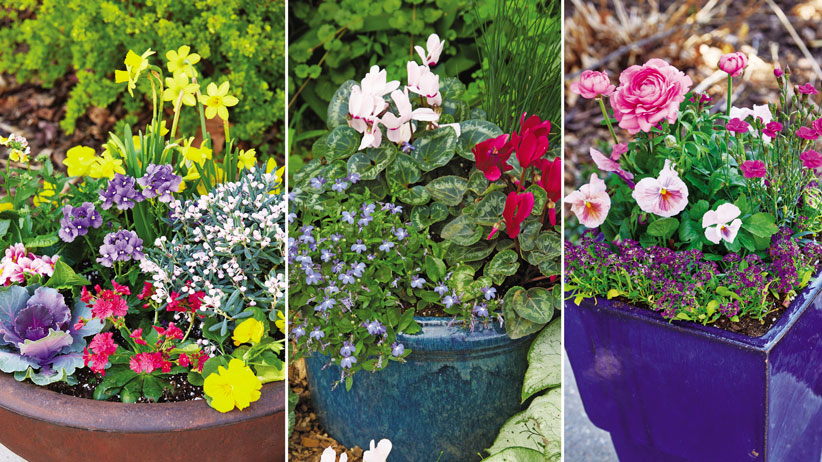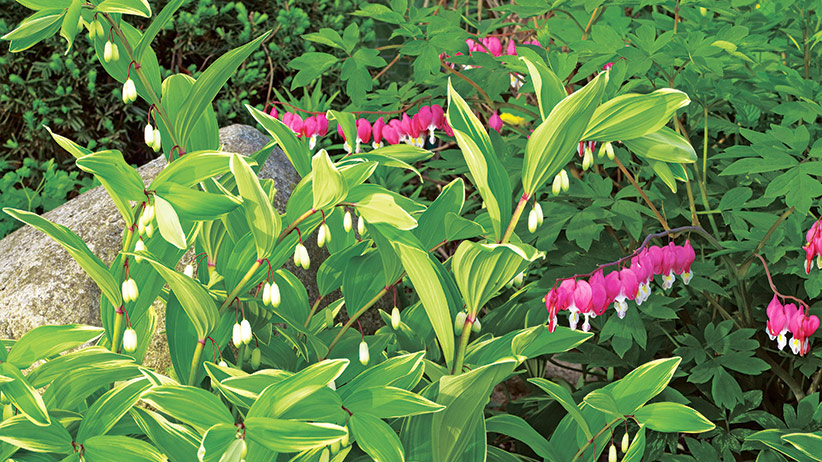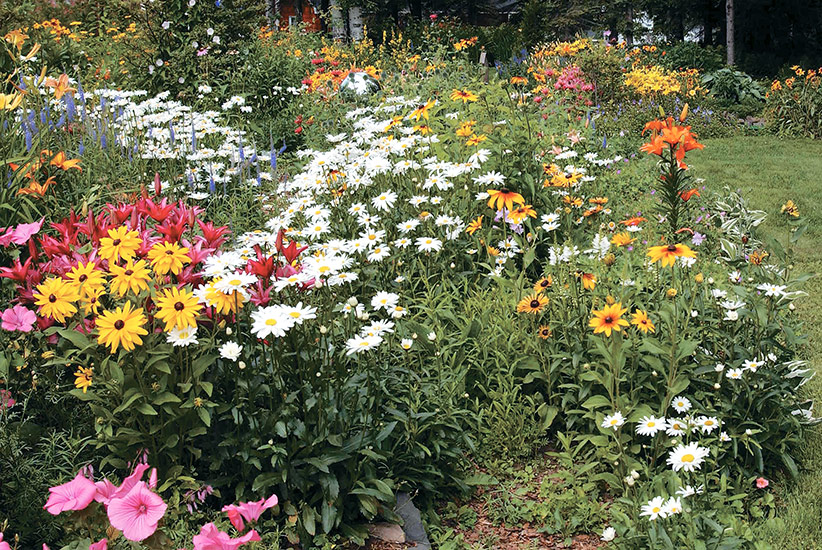
Designing with flower shape in mind
There are so many things to think about when designing a garden that it can be overwhelming, sometimes even intimidating. So if you’re wondering how to begin choosing your plants, start with flower shape.
Flowers come in all kinds of shapes, from simple daisies to sophisticated lilies. And while color is often the first thing that comes to mind, flower shape also helps set a mood and is an important element in garden design. To get just the effect you want, you need to know the eight categories of shapes. Then we’ll discuss some more design tips and help you find the right flower for the shape you need with our chart below.
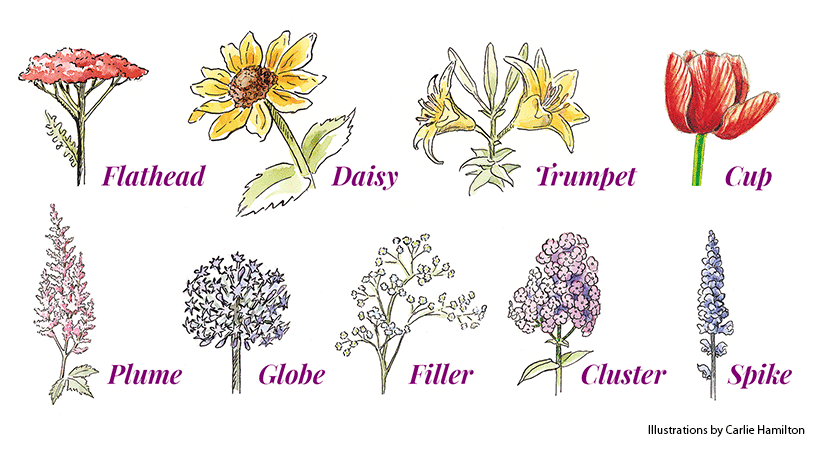
A variety of flower shapes for your garden
-
Flathead flowers have a horizontal shape that gives the eye a place to rest and has a down-to-earth feel.
-
Daises are the flower shape to choose for a simple, natural look.
-
Trumpets are strong, attention getting flower shapes and can be used as a focal point in the garden.
-
Cup flowers are simpler than trumpet flowers and lend a more casual feel.
-
Plumes bring a playful mood with fuzzy flowers. Plumes make a good transition shape between spikes and flatheads.
-
Globes’ unusual shape stands out. Use them as accents or focal points.
-
Fillers provide a good-looking backdrop and fill in bare spots.
-
Clusters of flowers provide some weight to a design. Loose clusters make good transitions between different shapes because of their indistinct form.
-
Spike flowers are great attention getters that add height to your garden design.
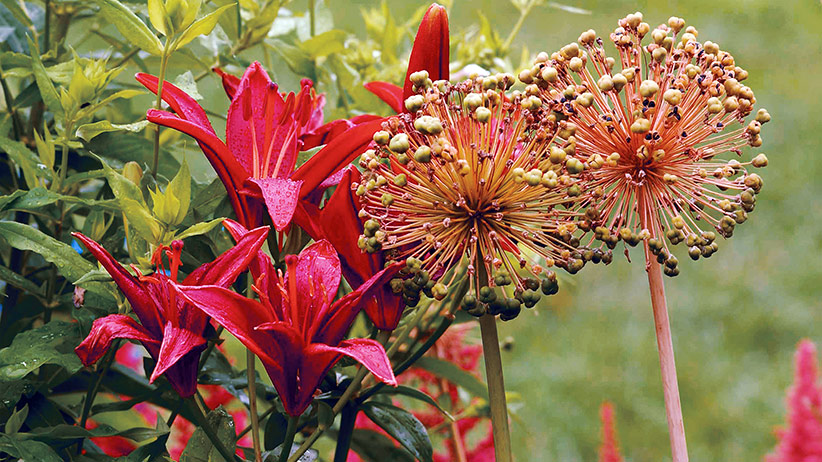
Tips for combining flower shapes
1. Repeat shapes for unity
Planting a lot of different shapes will keep your eye moving throughout the entire garden. This makes it more interesting to look at — your eye keeps seeking the next shape. On the other hand, too much contrast can create a confusing jumble. Remedy the situation by repeating a shape to provide a sense of unity. Even a wild color combo like pink and orange, for example, can be unified if you keep your flower shapes simple. Pair hot-pink zinnias with flame-orange Mexican sunflowers and you have a combination that sizzles yet still looks tied together because they’re both daisy shaped.
2. Use a variety
To keep a monochromatic garden from becoming bland, use a variety of shapes. You could never call a garden of spider flower, Asiatic lilies and delphiniums boring — even if they were all white!
3. Show off a specimen plant
Choosing the right shape combination can really show off a speciman plant. For example, if you want to spotlight a favorite lily, plant it with a filler like baby’s breath, which isn’t such an eye-catching shape, to make the lily the star.
4. Think about the seedheads
Don’t forget — flowers change with the seasons. Take advantage of the shapes of seedheads and blooms, like coneflowers, that dry out on the stem to add year-round interest to your garden.
You Might Also Like:
Garden design & helpful how-to gardening videos
Best flowers for butterflies
How to design a garden to attract more pollinators
Our mix & match guide to a perfect cottage garden
A no-fail formula for beautiful garden containers every time
Flowers of every shape
Here’s an alphabetical list of flowers and their shapes to help you mix and match and create your own combinations. Enjoy!
| Flathead | Daisy | Trumpet | Cup | Plume |
|---|---|---|---|---|
| Angelica Angelica gigas |
Anemone Anemone x hybrida |
Amarylis Hippeastrum hybrids |
Balloon flower Platycodon grandiflorus |
Astilbe Astilbe hybrids |
| Annual statice Limonium sinuatum |
New England aster Aster novae-angliae |
Asiatic lily Lilium hybrids |
Crocus Crocus spp. |
Canadian burnet Sanguisorba canadensis |
| Butterfly weed Asclepias tuberosa |
Blanket flower Gaillardia grandiflora |
Beardtongue Penstemon spp. |
Five-spot Nemophila maculata |
Coral bells Heuchera hybrids |
| Candytuft Iberis spp. |
Bloody cranesbill Geranium sanguineum |
Bellflower Campanula punctata |
Lavatera Lavatera trimestris |
Eulalia grass Miscanthus sinensis |
| Dill Anethum graveolens |
Dianthus Dianthus chinensis |
Daylily Hemerocallis spp. |
Lenten rose Helleborus orientalis |
Foamflower Tiarella hybrids |
| Joe pye weed Eupatorium fistulosum |
Purple coneflower Echinacea purpurea |
Flowering tobacco Nicotiana alata |
Musk mallow Malva moschata |
Goatsbeard Aruncus dioicus |
| Lantana Lantana hybrids |
Sea holly Eryngium giganteum |
Gentian Gentiana spp. |
Oriental poppy Papaver orientale |
Goldenrod Solidago spp. |
| Myrtle spurge Euphorbia myrsinites |
Shasta daisy Leucanthemum superbum |
Gladiola Gladiolus hybrids |
Pasque flower Pulsatilla vulgaris |
Meadow rue Thalictrum delavayi |
| Showy stonecrop Sedum spectabile |
Sneezeweed Helenium autumnale |
Morning glory Ipomoea tricolor |
Peony Paeonia hybrids |
Meadowsweet Filipendula purpurea |
| Sweet cicely Myrrhis odorata |
Stoke’s aster Stokesia laevis |
Peruvian lily Alstroemeria hybrids |
Prairie gentian Eustoma grandiflorum |
Pampas grass Cortaderia selloana |
| Verbena Verbena bonariensis |
Sunflower Helianthus annuus |
Petunia Petunia hybrids |
Sundrops Oenothera fruticosa |
Queen of the Prairie Filipendula rubra |
| Yarrow Achillea hybrids |
Tickseed Coreopsis lanceolata |
Surprise lily Lycoris squamigera |
Tulip Tulipa hybrids |
Jupiter’s beard Centranthus ruber |
| Globe | Filler | Cluster | Spike |
|---|---|---|---|
| African lily Agapanthus spp. |
Baby’s breath Gypsophila paniculata |
Begonia Begonia hybrids |
Blazing star Liatris spicata |
| Angelica Angelica gigas |
Columbine Aquilegia spp. |
Catchfly Silene armeria |
Bugbane Actea spp. |
| Bachelor’s buttons Centaurea cyanus |
Crambe Crambe cordifolia |
Garden phlox Phlox paniculata |
Burnet Sanguisorba tenuifolia |
| Beebalm Monarda didyma |
Flax Linum perenne |
Lady’s mantle Alchemilla mollis |
Cardinal flower Lobelia cardinalis |
| Cardoon Cynara cardunculus |
Fountain grass Pennisetum spp. |
Maltese Cross Lychnis chalcedonica |
Hollyhock Alcea hybrids |
| Carnation Dianthus hybrids |
Gaura Gaura lindheimeri |
Nodding onion Allium cernuum |
Ligularia Ligularia dentata |
| Clustered bellflower Campanula glomerata |
Jewels of Opar Talinum paniculatum |
Pearly everlasting Anaphalis margaritacea |
Monkshood Aconitum spp. |
| Geranium Pelargonium hybrids |
Meadow rue Thalictrum delavayi |
Persian candytuft Aethionema grandiflorum |
Mullein Verbascum hybrids |
| Giant knapweed Centaurea macrocephala |
Mugwort Artemisia lactiflora |
Rodgersia Rodgersia aesculifolia |
Russian sage Perovskia atriplicifolia |
| Globe thistle Echinops spp. |
Muhly grass Muhlenbergia capillaris |
Spiderwort Tradescantia andersonia group |
Salvia Salvia spp. |
| Strawflower Helichrysum bracteata |
Sea lavender Limonium latifolium |
Sweet woodruff Galium odoratum |
Speedwell Veronica spicata |
| Tall buttercup Ranunculus acris |
Wand flower Dierama pulcherrimum |
Willow blue-star Amsonia tabernaemontana |
Torch flower Kniphofia hybrids |








